#huc for no. 1 group that needs to have mandated diversity hires
Explore tagged Tumblr posts
Text
On Heteromorphs & Heteromorphobia (Arcs VI - X , Hero Killer to Provisional License Exam)
(This post will also cover the bonus chapter “Tsuyu's Ribbity Diary.”)
Thank you all for your amazing response to last week's post, my goodness! I thought I'd found about all the audience I was likely to get for my harping about heteromorphic discrimination, so I was delighted to see a number of new names!
I do have to warn you all, if you haven't done much looking into my archives, that I'm pretty critical of BNHA these days, especially of the ways it insists on holding up individualistic solutions to problems clearly established as systemic in nature. That will become more apparent when I get into the post-war material, as the endgame is absolutely rotten with it.
This week, though, we'll start by getting out of the school to get a look at signs of and contributors to heteromorphobia in the wider world.
The Vs. Hero Killer Arc (Chapters 45-59)
Chapter 45:
Mina’s preferred alias, Alien Queen, in reference to the Xenomorph queen from the Aliens franchise, is turned down by Midnight. The reason for this is never made especially clear. Class 1-B gets away with a number of villainous or monstrous hero names, like Phantom Thief and Gevaudan, violent ones like Battle Fist, even an animal reference in Jack Mantis. But Mina, for whatever reason, gets pushed towards the indescribably twee Pinky instead. Does Midnight the R-rated hero not think girls should get to have hero names with some edge? Surely not; her entire persona is based on titillation. Length is clearly not a factor, given that Midnight personally approves Can’t Stop Twinkling. I don’t know exactly what went down here (from a Watsonian perspective, that is; the Doylist guesses are readily apparent and all eyeroll-inducing), so I will simply point out that a non-baseline gal wanted to name herself after a famous monster with acidic blood and was pressured into going with something cutesy based on her skin color instead. Bakugou’s choice gets turned down as well,[1] but he actually has “murder,” like, right there in the name; Alien Queen is quite roundabout by comparison!
Chapter 48:
Introduction of Uwabami, the Pro Hero gal with the head snakes. She’s a bit of a weird case. Given that all we know she does is find hidden people using the snakes’ keen senses, do they have some self-awareness that makes them able to communicate with her—a case somewhat like Tokoyami and Dark Shadow, perhaps? Does she just tap into their senses at will rather than being able to speak to them? Or are they rather just extensions of herself, with no particular consciousness of their own, and they function like what must be a fairly dizzying array of extra-sensory perception that she receives at all times? Whatever the case, she’s a model and celebrity, and thus our first clear example of a heteromorph who doesn’t seem to suffer for her looks. Her looks are, of course, quite accentuated, given that her hero costume is a low-cut evening dress with a slit in the side up to her hip. Other than the hair-serpents, she’s a baseline woman who checks all the boxes for modern beauty standards; she will serve in this fashion as a good predictor of other highly ranked heteromorphic Heroes.
Chapter 51+55:
Endeavor, as will be made clear in Chapter 55, doesn’t really have any idea what the Noumu’s deal is. As far as he knows, it’s just like any other villain—and yet in Chapter 51, he opens up with an attack that bathes the Noumu in flame anyway, and comments in 55 that he’s never known anyone to remain conscious after such an attack. While I think this mostly speaks to the general brutality with which villains are treated by heroes—much different from standard police practice in real-life Japan!—it’s nonetheless notable that the Noumu he attacked with such casual ferocity certainly doesn’t look very baseline to the casual eye, between the exposed brain, the significant height, and the crawling movement.
Chapter 56:
Midoriya is startled by Chief Tsuragamae’s “woof” interjections. He doesn’t comment on it out loud, so I’m not inclined to hold it against him (not like someone else I’m about to bring up), but it wouldn't be the first time he’s come across this kind of vocalization: Tsuyu makes ribbit noises pretty frequently.
Tsuragamae notes that the authorization of a certain class of people, called “heroes,” to weaponize their quirks against others was initially a heavily criticized decision, one which only garnered public support because those original heroes were careful to always obey the laws dictating the circumstances in which they used their quirks. He goes on to say, of using one’s quirk to inflict harm without explicit instruction from the powers-that-be, “Such action would represent a stunning breach of law.” Like Thirteen before him, he completely omits any mention of how such laws disproportionately affect heteromorphs, who can’t turn off a permanent physical trait, and, particularly in cases of people whose entire bodies are divergent, have little choice in whether or not to use their quirk in any sort of physical altercation that might lead to harm.
Shouto, angry over what he perceives as punishment for a good deed, calls Tsuragamae a mutt. The chief doesn’t react particularly strongly to this, but as the chief of police, you have to imagine he’s pretty used to the slings and arrows of public opinion. The incident passes without comment, but it will not be the last time we hear a Todoroki derisively referring to another human being as an animal.
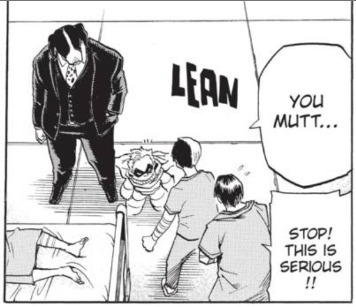
There are some sweatdrops and exhortations to get the kid to cool it, but those were ongoing before the animal words came out.
Chapter 57:
Gran Torino notes that the age they live in, for better or for worse, is one of suppression, and that the situation with Stain and the League will draw people out who are influenced by that ideology. Gran doesn’t elaborate on exactly what sorts of people he has in mind—All Might says only, “Then heroes will deal with them,”—but it’s an early hint that there are people in this society who feel unjustly suppressed. Crucially, Gran Torino doesn’t even necessarily think those people are wrong; he just thinks it’s a necessary evil. But what, exactly, is it that he’s grudgingly accepting as inevitable for the sake of maintaining the status quo? And how might his circumstances need to differ for him to have a different opinion?
In Chapter 27, we learned that producing support goods requires a government license; here we find out, courtesy of Giran, that dealing in and producing support goods without such a license is a major crime. So if you, for any reason, failed that “rigorous examination” to get cleared for support goods for quality-of-life reasons, you’re unlikely to find someone who’ll just provide them to you out of sympathy provided you keep quiet about where you got them. Instead, you have little choice but to turn to black market brokers—all because the government doesn’t think your quirk is affecting you negatively enough to qualify you for support equipment. Again, this isn’t specifically about heteromorphs, but someone having an emitter quirk they can’t control well who needs the support item because they are choosing to pursue a career requiring them to learn that control is a very different case than someone who needs government support because of an immutable, always-on physical trait.
This chapter contains the first appearances of both Gigantomachia and Spinner, both fairly extreme heteromorphs: Machia for his size and rocky hide, and Spinner for animal traits considerably more prominent than e.g. Tokoyami’s bird head or even Tsuyu’s conglomeration of mildly froggy traits. Indeed, Spinner’s heteromorphic traits are so much more prominent than something like Jirou’s earlobes that it hardly seems accurate to even categorize their bodies the same way.
The sidebar for Daikaku Miyagi, the anchorman with the quirk that gave him two big horns who amputated one so that it would be less in the way during newscasts and other things that required there to be a camera on him. This in and of itself wouldn’t necessarily be notable, save that the same extra goes on to describe how the decision garnered some backlash from “a certain human rights group” who said that decisions like his fostered discrimination and were linked to the rejection of quirk-based society on the whole. Horikoshi further notes that he enjoys thinking about the lives and stories behind minor characters—even this far back, then, three and a half years before the introduction of the CRC, we have concrete evidence that the author was thinking about quirk-based discrimination and the politicization of heteromorphic features.
Chapter 59:
All Might drops some exposition about the Advent of the Exceptional, during which we see an image of a crowd full of implied-quirkless people holding up signs proclaiming their humanity and the monstrosity of those with quirks. Conversely, three of the four quirked people we see have obvious physical divergence from baseline human appearance. So from early on, that “monster” turn of phrase was heavily associated with changes in the physical appearances of those with special abilities. Later on, the PLF advisor at the hospital will tie these two things together explicitly.
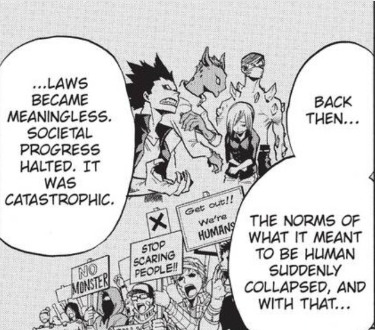
The Final Exams Arc (Chapters 60-69)
Chapter 61:
Ectoplasm’s character sheet. The teeth are creepy no matter which way you cut it, but they look much more profoundly unsettling when they’re right there on his unmasked face, as opposed to behind a black cowl, where you can let your eye fool you that they are in some way part of its design. His hero costume, naturally, includes the cowl, but his daily clothes do not—I wonder if he ever tried to have a gentle talk with Shouji about why Shouji wears the mask even in his downtime? I wonder even more how much the teaching staff in general, and Nedzu and Aizawa specifically, actually know about Shouji’s history. o It’s also noted that Ecloplasm looks scary, but has received continued support after coming back to the job after losing both legs in a fight with a villain—we see this same pattern with Jeanist after Kamino. No word on how regular his support was before the traumatic double limb loss, though.
Chapter 66:
Nedzu, we find, was “toyed with by humans in all sorts of ways in the past.” Nothing we know about him suggests that he has any particular longevity, but his dynamic with Endeavor,[2] many chapters down the line, does suggest to me that he was at least on the staff when with Endeavor was at UA some thirty years ago. Thirty years is within the span of All Might’s career, well after society began to stabilize with the formalization of the Hero System. And yet, despite that, a sentient being, one with human—above human!—intelligence, was mistreated badly enough that he bears a grudge to this day. Nedzu is, again, not in precisely the same situation as a human heteromorph, but he serves as an indicator of what humans have, even in the age of heroes, been willing to do to those they think of as “animals.”
A shot of Koda and his mother, who look much alike. Interestingly, the biggest difference in their appearance is that she has horn-like protrusions that her son lacks. We’re a long way from the first quirk evolutions, and even farther from Koda’s quirk evolution, but we will later see Koda’s mother specifically tie those horns to her animal communication quirk becoming more powerful. This makes for another good piece of evidence towards Horikoshi having a grasp of heteromorphobia from early on, as the evidence is pretty good that Koda-mama got those horns as a result of a quirk evolution of her own, and those don’t happen under normal, non-stressful circumstances. More on Koda’s parents in a bit, as they're a pretty stand-out case in another way that isn’t immediately apparent here.
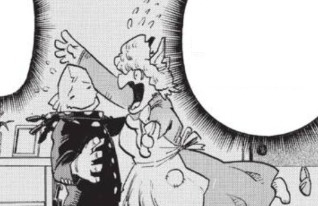
Can we call it foreshadowing for Koda defending Shouji at the hospital that Koda is wearing the same scarf as the main character in Horikoshi's Oumagadoki Zoo? Hmm. I'll leave that one to codenamesazanka.
Chapter 67:
A flashback panel to Mineta’s days in middle school. While I don’t doubt that there are P L E N T Y of reasons Mineta would be unpopular with the girls in his class, it is nonetheless notable that the popular boy getting showered with attention is perfectly baseline, while Mineta and his friends are not.
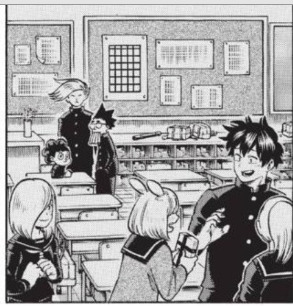
Note also that the cute heteromorph girl has long-ish ears and no other obvious divergent features.
Chapter 68:
Shouji and Iida are specifically called out to at the mall, trying to attract them as customers with claims that whichever storefront employee is hailing them can help them find anything they need. Midoriya mutters to himself about the difficulties of catering to everyone, given the many different types of quirks scattered across multiple age groups.
Crowd scenes at the mall show scattered numbers of heteromorphs, a somewhat higher number than usual for such civilian crowd scenes. The Kiyashi Ward Shopping Mall is noted for being the biggest and trendiest in the prefecture, with a variety that attracts lots and lots of people, so perhaps it’s no surprise to see somewhat more heteromorphs than usual there.
The Forest Training Camp Arc (Chapters 70-83)
Chapter 70:
Introduction of the Wild Wild Pussycats. A team of three Emitters and a Transformation-type, none of them in the slightest heteromorphic (give or take Tiger’s permanent :3 mouth), they nonetheless theme themselves after cats, including fake tails, big costume paw gloves, and cat-ear-esque headsets. It’s cute and unobjectionable in and of itself, but I do wonder what people like e.g. Officer Sansa think of it.
Chapter 71:
Shouji is missing from the hot springs scene. It doesn’t hugely stand out in the moment because Aoyama and Sero aren’t there either, but it does read a bit differently with the benefit of hindsight. Given the strong possibility that Aoyama is off doing Traitor Activities and Shouji is avoiding any possibility of having to torpedo the hot springs fun-times with an explanation of that time he was savagely beaten by people in his hometown right in an open street, it kinda leaves Sero as the only one who maybe just skipped for normal reasons, like that hot springs would gunk up his tape or something.
Chapter 73:
Bakugou addresses Ojiro as “Tail”—referring to him by his heteromorphic trait. He’s not even particularly angry at the moment; he’s just still nursing a grudge about Todoroki’s underwhelming performance in their Sports Festival match and wants to swap partners for the Test of Courage. Early Bakugou is very much a “judge a person by their quirk” sort.
Pixie Bob ushers Tsuyu and Ochaco into the woods for their turn at the Test of Courage by referring to the latter as Uraraka-kitty and the former as Ribbit-kitty.[3] While in the English, this reads as a baseline woman in a cat costume referring to the heteromorphic student by her animal-themed verbal tic and the baseline student by her actual name, uraraka is a fairly onomatopoeic way to say bright and cheerful. I would guess that Pixie Bob is probably referring to Ochaco’s personality here, which makes it somewhat less egregious. It won’t be the last time someone refers to Tsuyu via the frog sound instead of her name, though.
Chapter 75:
Mandalay telepathically compliments Spinner, calling him both cool and handsome. While I doubt he’s the only person in the world who’d react the way he does—he blushes, gets flustered, and missteps, giving Mandalay an opportunity to attack him—the moment does get some new context when you consider how everyone called him “the lizard freak” in his hometown. Approximately zero people calling him cool and handsome back there, one imagines! Having it immediately turn out to be a ploy likely informs some of the outraged anger in his response.
Chapter 81:
Mandalay points out that Spinner never used his quirk during their combat, implying that she doesn’t think just his lizard-like appearance or his claws “count.” Chalk another one up to the classification problems of “heteromorph” as a descriptive term. This will turn out to rather neatly illustrate one of the issues I’ve been talking about with regard to the way heteromorphs are unfairly disadvantaged by the current laws about public quirk use. Remember, a “Villain” is someone using their quirk illegally. So if Mandalay doesn’t think Spinner used a quirk here, and since he has no record, why does he get categorized as a Villain instead of just a garden variety criminal? Now, one could say that by associating with the League of Villains, Spinner is rather claiming the designation for himself, and we don’t know how the legal system will technically classify him, when and if he ever actually faces trial. To that, I would say to hold the thought, because Skeptic will eventually back me up on the, “Heteromorphs are unfairly targeted by Villain designations,” claim all but word for word.
BONUS CHAPTER 1: Tsuyu’s Ribbety Diary
We meet Tsuyu’s family, all various froggy types. They’re a cute family, but the husband and wife both being froggy kind of raises some questions about pressures that might exist about marrying your same “type,” or at least refraining from marrying anyone too obviously not. I’d be more willing to wave it off if not for two things. First, we get the same sort of scenario from Spinner’s character sheet, that his is “a family full of reptilian quirks.” Second, there are very few romances in the series between someone close to “baseline” and someone with a more extreme heteromorphic appearance. The most obvious, clear-cut, canonical example is Koda’s parents—his dad has slightly weird hair but is otherwise entirely baseline; we see him defending his wife from other peoples’ mockery. That, of course, is a single panel limited to a flashback inside a flashback, so not exactly very visible to the reader! The next-most significant one I can come up with is Natsuo and his mouse girlfriend, who has likewise been seen in one (1) panel, had no dialogue, and whose appearance and identity were so incidental the anime deleted her entirely. Who’s next? Well, if you assume all those No Comments from Kamui Woods and Mount Lady about their relationship are indicative of a relationship between them, they’d be another, though we don’t actually know what Shinji actually looks like under his mask, only the implication that it’s divergent enough that he prefers to cover his face. Next up on my tally would be Thief Takami and Tomie, but since the sum total of Takami’s animal traits are tiny little elbow wings, you can see how fast the drop-off is there. Compare this to the number of pairings/families we have between people of like type: Bakugou’s parents, Iida’s, Jirou’s, Aoyama’s, Tsuyu’s, Ochaco’s, Shouto’s, Toga’s, Spinner’s, and Tomura’s whole family on both sides. Then you get the ship-teasy stuff that’s more about crushes, people dating, or hints that are perceived as pointing towards epilogue romances: Deku and Ochaco, Jirou and Kaminari, Shindo and Yo, Gentle and La Brava, Miss Joke’s flirting with Aizawa, and Toga’s variety of crushes (among which Tsuyu is the most distant from Toga’s own body type).[4] I think Kirishima and Mina are right on that borderline, with Mina having a normal body type but a collection of minor but highly visible divergent traits. So like, the vast, vast majority of the romantic relationships in the show are between relatively baseline people. In that context, it sticks out like a sore thumb to me that Tsuyu and Spinner are both explicitly said to have the same type of animal heteromorph quality on both sides of their family tree. It’s not an incest concern or anything, just that I wonder what the pressure is on cross-type couples, or what social circles look like post-graduation.
Two classmates talk about how it’s hard to tell what Tsuyu is thinking; one of them says, with her eyes hooded and a kind of cool expression, “That expression of hers never changes. Maybe ‘cuz she’s a frog?”
Tsuyu tells us that she never really made any friends; while some of this may simply be because Tsuyu didn’t have much time to socialize, between hero training and looking after her family, it’s also true that all of her classmates that we see have baseline appearances.
This lasts until she starts getting stalked by a snake-headed heteromorph girl named Mangusu Habuko—a fellow loner. Tsuyu is initially frightened by Habuko’s behavior, but has an intuitive sense for what the deal is, that Habuko wants to be friends but is awkward and doesn’t know how to broach it.
When asked if she wants to be friends, Habuko flips out. She calls herself treacherous and untrustworthy; she calls Tsuyu a foolish frog and says she must be joking, and that she should choose her friends more carefully. She then immediately dissolves into tears. Somehow, I doubt all this self-loathing about her innate nature manifested out of thin air!
The Hideout Raid Arc (Chapters 84-97)
Something that’s observable throughout this arc is that we’re in another sequence, like the Sports Festival, where the percentage of people with heteromorphic features in the crowd shots tends to run a bit higher than the norm of the series to date. Unlike the Sports Festival, though, these crowds are just civilians, not heroes. So what’s the difference between Kamino and the earlier on-the-street crowd scenes? Well, the neighborhood the Noumu warehouse is in is a somewhat rougher area. Part of the visual shorthand for that is people in edgier clothes, stuff that’s indicative of districts with bars, clubs, sleazy hangout spots, and so forth, but another shorthand is an increased number of heteromorphs.
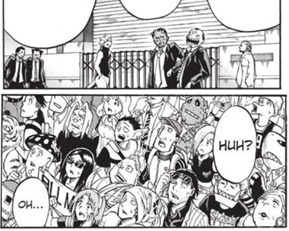
These panels are respectively from Chapters 87 and 92.
Chapter 87:
The character sheet for Kamui Woods notes that the story of his early childhood is “grand and compelling,” and that his story was made into a documentary. That, to me, has Inspiring True Story written all over it. Probably not coincidentally, Kamui Woods is another character whose face we’ve never seen. As more pointing in the direction of him having a childhood marked by severe discrimination, he’s not sure of his age—it’s given as “29 since he started counting.” So was he abandoned as an infant for his weird face? I could come up with other explanations, all equally over the top (extreme confinement, for example, that left him unable to properly mark the passage of time), but the fact that he can’t e.g. look up a birth certificate for himself suggests that whatever went so wrong for him, it happened very early. …Though I suppose there’s the possibility that he’s not human, but rather a tree that manifested a quirk. As documentary-worthy origins go, though, that feels less Inspiring True Story and more Educational Biopic About Rare Phenomenon.
The Provisional Hero License Exam Arc (Chapters 98-121)
Chapter 99:
Shouji’s room is shown, all but barren. He says that he doesn’t care much about owning things, but knowing what we come to know about his history, it’s easy to wonder if he really doesn’t care about owning things or if this is rooted in a childhood in which it was believed that anything he touched would be polluted. Not a situation that led to him being given much of his own, one suspects!
Chapter 103:
This chapter introduces Yokumiru Mera, from the HPSC, who gives an opening statement that has some very interesting ruthlessness lurking in its subtext. Particularly relevant to our current topic is his comment that in the modern era, the time it takes to resolve a given incident is incredibly short, so the test that year will be prioritizing speed. Prioritizing speed (wouldn’t want some other hero to get the metaphorical kill first, after all!) is a surefire way to guarantee that heroes are not taking the time to really examine all factors in a situation or make any attempts whatsoever at calm, considered de-escalation, but rather are just making snap judgements based on their biases and gut reactions. Guess what group of people that’s going to disproportionately impact? o Now, it’s notable that Mera says the test prioritizes speed, but the conclusion many others come to is that the test only pretends to do so; that actually, it prioritizes care and information gathering. Indeed, we find a few chapters later that the actual priority is teamwork, as requested by police higher-ups—the idea is to fill in the gap left behind by All Might with hero squads that work well together.[5] However, while the intention may be to gather those good at teamwork, it certainly doesn’t stop people like Shouto and Inasa from cruising through—and, in any case, whether the groups learn teamwork or not doesn’t take away from an HPSC rep telling them to their face that speed of incident resolution is one of the most important things to a modern hero and never following that up with any kind of amendment or clarification.
Chapter 107:
Introduces the HUC, or Help Us Company, professionals trained to act as victims in disaster rescue exercises. Given that context—what they’re communicating to students training to understand what “victims” look and act like—it’s extremely worth examining what they, well, look like.
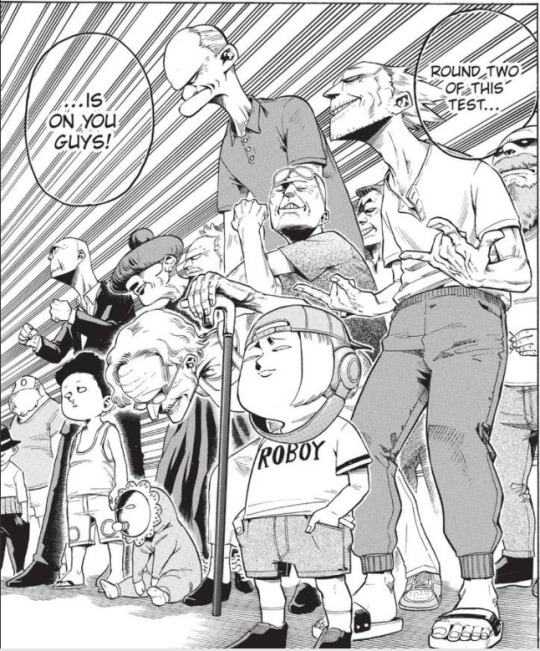
God, this is so Yikes.
And having asked that question, we find that the only people in this group that might not be baseline—the ones with short, childlike statures—are dressed to emphasize that stature. The end effect is a crowd of “victims” with not a single heteromorphic representative.
Chapter 109:
Shiketsu’s class rep, Mora Nagamasa—the extremely hairy one—approaches Bakugou to extend an apology for Shishikura’s behavior during the exam. It’s noticeable here that, having matured somewhat since Early Series Bakugou, and having been approached in downtime in a reasonable manner, Bakugou manages to refrain from coming up with any demeaning nicknames centered on Mora’s appearance. Kirishima remarks internally on all the hair, but only internally; he’s much too polite to say anything out loud.
Chapter 110:
A big splashy introduction for the man ranked #3 in the Heroes Who Look Like Villains ranking, Gang Orca. He’s at the test to play villain and is, just as noticeably as all the play-victims are baseline, a heteromorph. At the time of his introduction, he’s ranked Number 10 in the Hero Rankings, but will be bumped out later on. This does, however, make him the highest-ranked known heteromorph who doesn’t have a human face,[6] with the possible exception of Kamui Woods—who, like Shouji, covers it with a mask.
Gang Orca’s character sheet notes that, while he’s a popular guest at aquariums, his intimidating face and “stony personality” always result in weepy children. He apparently finds this relatively upsetting (“lots of angst”) but, unlike Shouji or Kamui Woods, has not taken to wearing a mask, nor trying to tone down his personality on any level—to the contrary, Present Mic suggests much later on that he exaggerates it.
-----------------
Next time, I'll cover from the Shie Hassaikai arc through the end of Joint Training. Thanks for reading!
--------------------- FOOTNOTES ---------------------
[1] Initially. He sticks to his guns long enough that he gets away with it in the end, though.
[2] The big tell is that Nedzu addresses Endeavor as Todoroki-kun rather than Todoroki-san or simply by his hero name, but his observation that Todoroki-kun has “matured” (literally in the Japanese, “become an adult”) doesn’t hurt, either.
[3] Kerokero neko and Uraraka neko.
[4] You can get further out there with this, but by the time you get to e.g. Shouto and Momo or Ojiro and Hagakure, the ice is definitely getting thinner on whether you’re seeing groundwork for future wedding bells or just reasonably close male/female friendship. Your mileage may vary depending on how tightly attached your shipping goggles are or how cynical you are about shounen authors’ tendencies towards timeskip marriages. Also, I can’t be bothered to dig up and list out the crushes or shipping patterns among the Class B kids. Koroiro likes the mushroom gal?
[5] Note that Mera phrases this as being merely a stopgap until they find the next All Might. The HPSC is not so eager to change the methods they’ve come to rely on over the last thirty some-odd years!
[6] We don’t know enough for me to say for sure whether Wash is a heteromorph.
#bnha#heteromorph discrimination plot#on heteromorphobia#my writing#bnha meta#bnha worldbuilding#huc for no. 1 group that needs to have mandated diversity hires#seriously there needs to be a lawsuit or something#where's that “certain human rights group” when you need them
82 notes
·
View notes